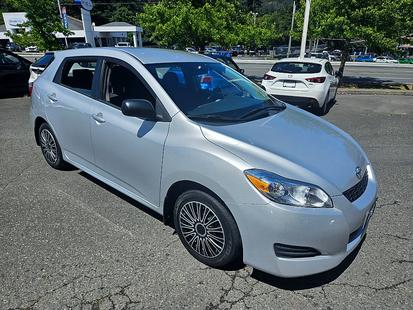The Toyota Matrix is a versatile compact hatchback that was produced by Toyota from 2002 to 2014. Known for its practicality and reliability, the Matrix was designed to appeal to buyers seeking the utility of an SUV with the maneuverability and fuel efficiency of a smaller vehicle. Positioned as a sporty alternative to a traditional sedan, the Matrix carved out a niche in the compact car segment.
History and Background
Launched in 2002, the Toyota Matrix was developed in conjunction with General Motors, who marketed a sibling vehicle, the Pontiac Vibe. The Matrix was built to combine the functionality of a compact SUV with the efficiency of a small car, which made it particularly appealing to urban dwellers and small families.
The Matrix saw two generations during its production run. The first generation (2003-2008) established its reputation for reliability and practicality, while the second generation (2009-2014) brought about improvements in styling and technology. Despite its popularity, the Matrix was discontinued in 2014 as Toyota shifted focus to other models in its lineup.
Key dates:
- 2002: Toyota Matrix introduced
- 2008: Second generation launched
- 2009: Major redesign with updated features
- 2014: Production of the Matrix ended

2014 Toyota Matrix
$15,995
90,098 miles
Performance and Handling
| Variant | Engine | Power | 0-60 | Top Speed | Fuel Economy |
|---|---|---|---|---|---|
| Base | 1.8L I4 | 130 hp | 8.9s | 118 mph | 25/31 mpg |
| XR | 2.4L I4 | 158 hp | 7.8s | 126 mph | 21/28 mpg |
| XRS | 2.4L I4 | 158 hp | 7.5s | 130 mph | 21/28 mpg |
Interior and Comfort
| Feature | Base | XR | XRS |
|---|---|---|---|
| Air Conditioning | ✓ | ✓ | ✓ |
| Power Windows | - | ✓ | ✓ |
| Cruise Control | - | ✓ | ✓ |
| Sunroof | - | ✓ | ✓ |
| Leather Seats | - | - | ✓ |
Technology and Features
Technology by Model Year:
- 2009: Introduced Bluetooth and satellite radio
- 2011: Added USB connectivity and updated audio system
Infotainment System:
- Screen size: 6.1-inch touchscreen (available in later models)
- Features: AM/FM radio, CD player, Bluetooth connectivity, USB port
- Connectivity: Bluetooth, USB
Driver Assistance Features:
- Standard: ABS, traction control, stability control
- Optional: Navigation system, rearview camera
Safety
The Toyota Matrix consistently performed well in crash tests, offering peace of mind to safety-conscious buyers. It featured a robust array of safety equipment, including multiple airbags and electronic stability control.
Safety Ratings:
- NHTSA Rating: 4 stars
- IIHS Rating: Good
Safety Features:
- Standard: Front and side airbags, ABS, traction control, stability control
- Optional: Rearview camera, tire pressure monitoring system
Value for Money
| Year | Condition | Price Range |
|---|---|---|
| 2010 | Excellent | $8,000-$11,000 |
| 2012 | Good | $7,000-$9,500 |
| 2014 | Fair | $5,500-$7,500 |
Running Costs:
Running costs for the Matrix were generally low, thanks to its efficient engines and Toyota's reputation for reliability. Regular maintenance was straightforward, with parts readily available and reasonably priced.
- Fuel Economy: 25/31/28 mpg (city/highway/combined for base model)
- Service Intervals:
- Oil Change: Every 5,000 miles
- Major Service: Every 30,000 miles
- Common Repair Costs:
- Brake pads: $150-$300
- Alternator replacement: $400-$700
Known Issues by Year:
- 2009: Some models experienced water pump failures
- 2011: Reports of squeaky front suspension
Competitor Comparison
Competitor 1: Honda Fit
- Market Position: The Honda Fit is a subcompact hatchback known for its excellent cargo versatility and fuel efficiency.
- Features Comparison: The Fit offers a more flexible Magic Seat system but lacks some of the Matrix's power options.
- Price Comparison: Generally priced slightly lower than the Matrix, appealing to budget-conscious buyers.
- Running Costs: The Fit boasts better fuel economy and similar maintenance costs.
Competitor 2: Mazda 3 Hatchback
- Market Position: The Mazda 3 Hatchback is known for its sporty handling and stylish design.
- Features Comparison: The Mazda 3 offers more upscale interior materials and superior driving dynamics.
- Price Comparison: Priced similarly, though higher trims can go beyond the Matrix's range.
- Running Costs: Comparable running costs, with slightly better fuel economy in newer models.
Competitor 3: Ford Focus Hatchback
- Market Position: The Ford Focus Hatchback offers a balance of performance and practicality.
- Features Comparison: The Focus boasts more advanced tech options and a more modern design.
- Price Comparison: Often available at a similar price point with occasional incentives.
- Running Costs: Slightly higher repair costs but competitive fuel economy.
Verdict
The Toyota Matrix is a reliable, practical, and versatile compact car that stands out for its utility and low running costs. While it may not excite driving enthusiasts with its performance, it delivers where it counts for everyday use. With its spacious interior and strong safety record, the Matrix remains an excellent choice for those seeking practicality and reliability in a used vehicle.